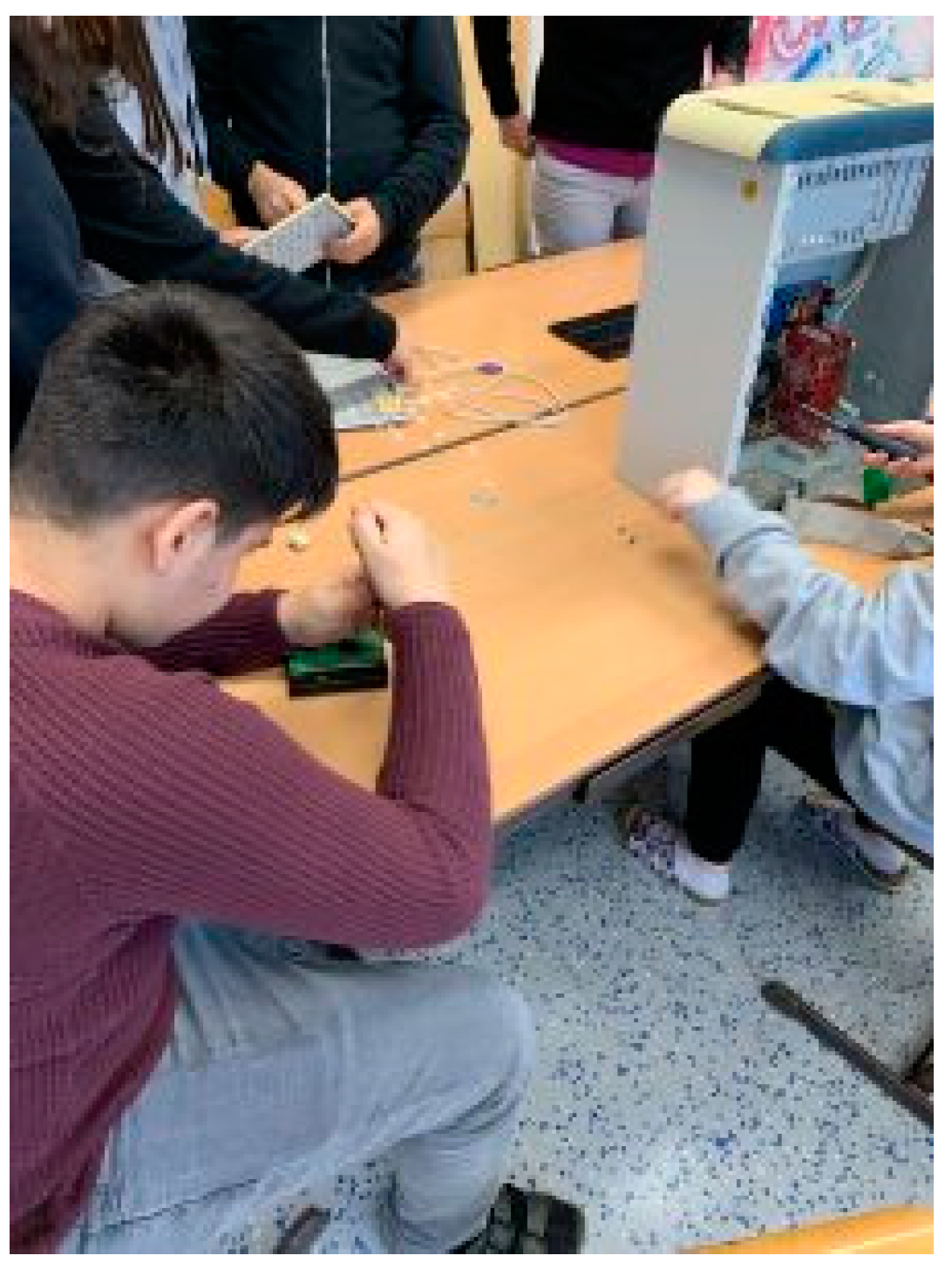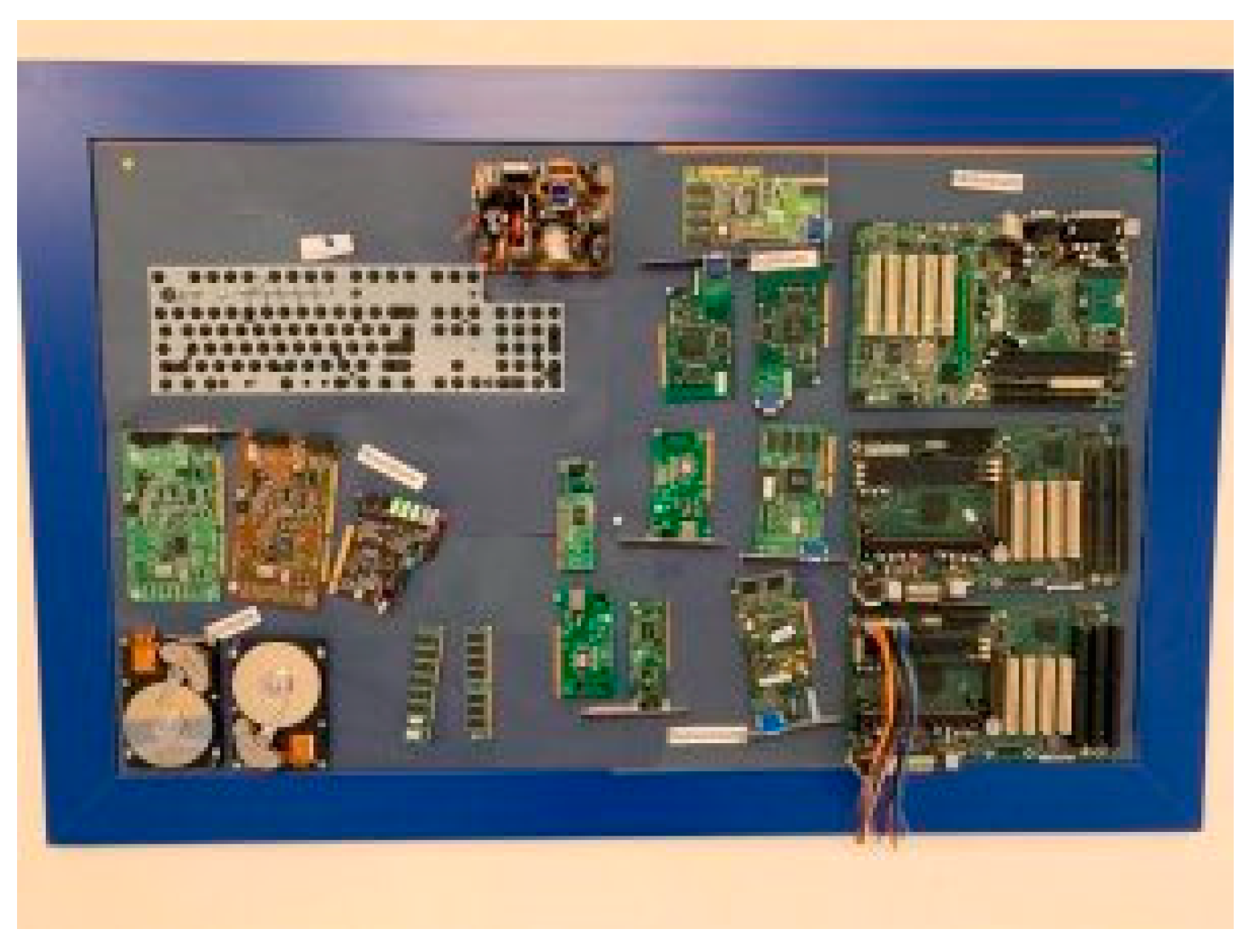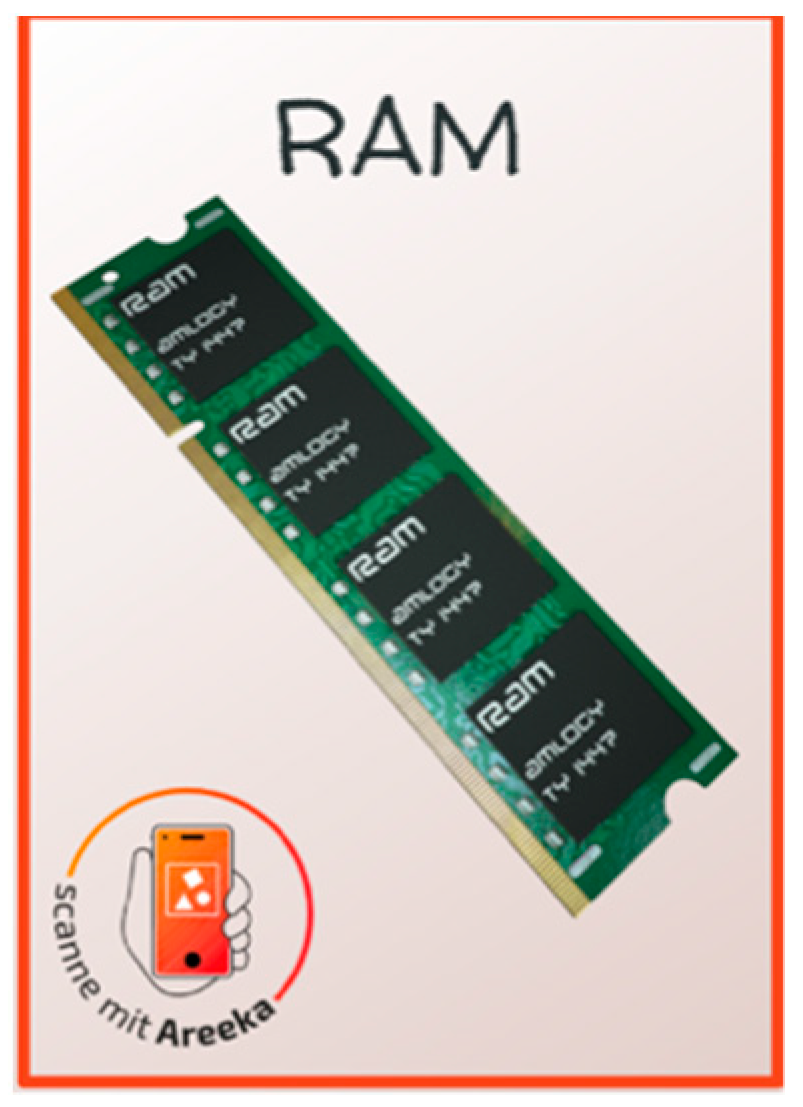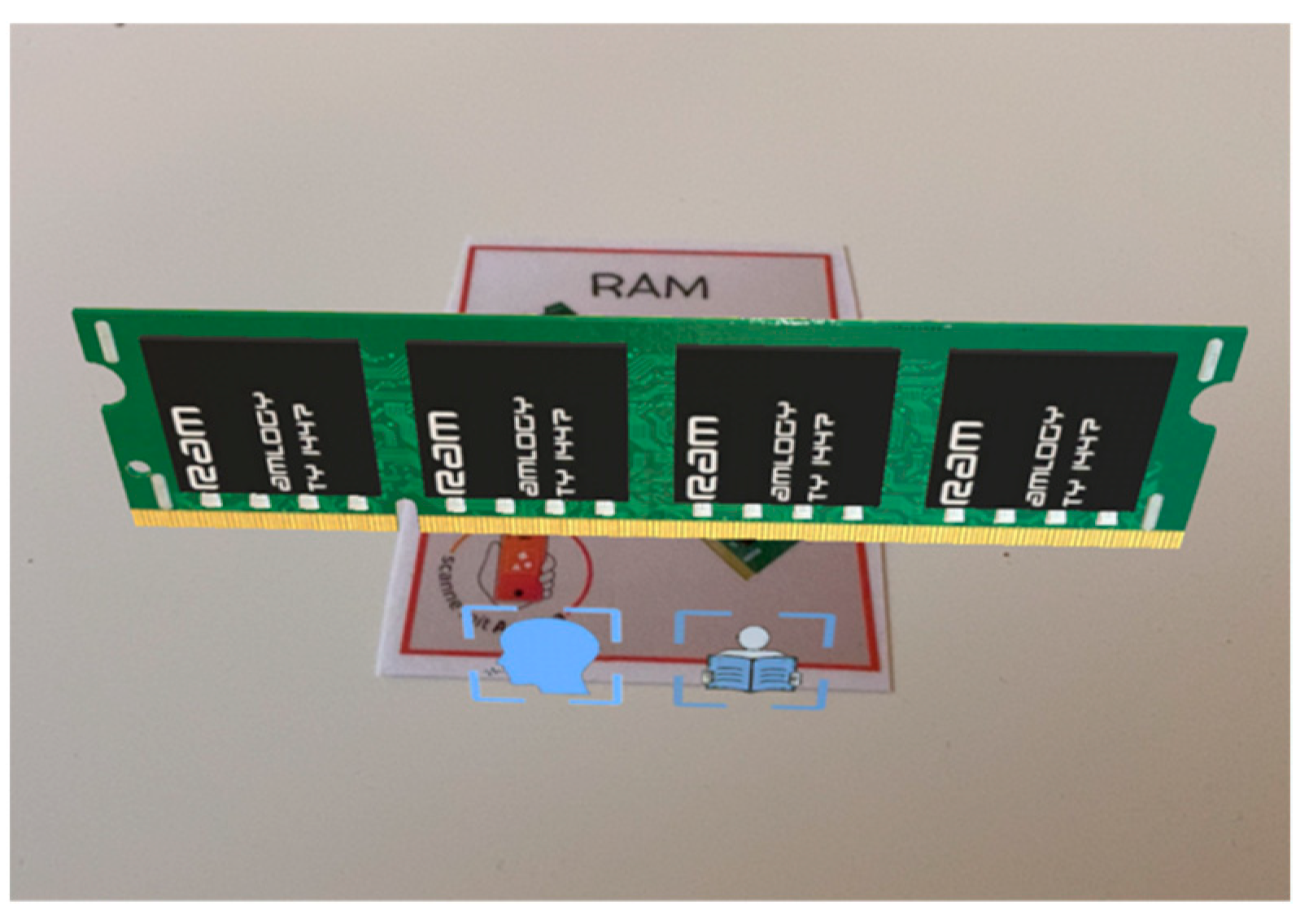Students as Designers of Augmented Reality: Impact on Learning and Motivation in Computer Science
Abstract
:1. Introduction
2. Literature Review
2.1. Design-Based Learning (DBL)
2.2. Potentials of DBL
2.3. Challenges Associated with DBL
3. The Present Study
4. Method
4.1. Participants and Context
4.2. Guided DBL for AR Artifact Creation
- Clarifying design specifications and constraints
- Researching and investigating the problem
- Generating alternative designs
- Choosing and justifying the optimal design
- Developing a prototype
- Testing and evaluating the design solution
- Redesigning the solution with modifications
- Communicating the achievements.
4.3. Data Collection and Instruments
5. Results
5.1. Scoring, Data Analysis, and Descriptive Statistics
5.2. Learning Performance
5.3. Motivation
6. Discussion
7. Limitations and Future Research
8. Conclusions and Implications
Author Contributions
Funding
Institutional Review Board Statement
Informed Consent Statement
Data Availability Statement
Acknowledgments
Conflicts of Interest
Appendix A
| Intrinsische Motivation | Intrinsic Motivation |
| Was ich im Technologie-/Informatikunterricht lerne, ist für mein Leben wichtig. | What I learn in technology education is relevant for my life. |
| Der Technologie-/Informatikunterricht ist interessant. | Technology education is interesting. |
| Das Lernen von Technologie-/Informatik-Inhalten macht mein Leben sinnvoller. | Learning about technology makes my life more meaningful. |
| Ich bin neugierig zu erfahren, was es in der Welt der Technologie/Informatik zu entdecken gibt. | I am curious about discoveries in technology. |
| Es gefällt mir, technologische und informatische Inhalte zu erlernen. | I enjoy learning about technology. |
| Selbstwirksamkeit | Self-Efficacy |
| Ich bin zuversichtlich, dass ich eine gute Leistung im Technologie-/Informatikunterricht zeigen werde. | I am confident I will do well in technology education. |
| Ich bin zuversichtlich, dass ich bei Technologie-/Informatik-Projekten gut abschneide. | I am confident I will do well on technology projects. |
| Ich glaube, dass ich die inhaltlichen und praktischen Anforderungen im Technologie-/Informatikunterricht meistern kann. | I believe I can master technology knowledge and skills. |
| Ich glaube, ich kann mich bei technologischen und informatischen Themen verbessern. | I believe I can improve in technology education. |
| Ich bin sicher, dass ich die Inhalte im Technologie-/Informatikunterricht verstehen kann. | I am sure I can understand technology education content. |
| Selbstbestimmung | Self-Determination |
| Ich wende genügend Energie für das Lernen im Technologie-/Informatikunterricht auf. | I put enough effort into technology learning. |
| Ich verwende Strategien, die mir ein gutes Lernen im Technologie-/Informatikunterricht ermöglichen. | I use strategies to learn well in technology education. |
| Ich wende viel Zeit für das Lernen im Technologie-/Informatikunterricht auf. | I spend a lot of time learning technology. |
| Ich beschäftige mich auch außerhalb der Schule mit Technologie und Informatik. | I also engage with technology outside of classes. |
| Ich arbeite intensiv, um die Inhalte des Technologie-/Informatikunterrichts zu verstehen. | I study hard to understand technology. |
| Karriereaussichten | Career Motivation |
| Das Lernen im Technologie-/Informatikunterricht wird mir helfen, später eine gute Stelle zu finden. | Technology education will help me get a good job. |
| Kenntnisse aus dem Technologie-/Informatikunterricht werden mir einen Karrierevorteil verschaffen. | Knowing technology will give me a career advantage. |
| Technologie und Informatik zu verstehen, wird für meine Karriere nützlich sein. | Understanding technology will benefit me in my career. |
| Meine Berufslaufbahn wird auch mit Technologie/Informatik zu tun haben. | My career will involve technology. |
| Ich werde in meiner Karriere die Fähigkeit, mit Technologie/Informatik Probleme zu lösen, brauchen. | I will use technology-related problem-solving skills in my career. |
| Note. Original SQM-II © 2011 Shawn M. Glynn, University of Georgia, USA. Available under https://coe.uga.edu/assets/downloads/mse/smqii-glynn.pdf (last access 15 May 2021). | |
References
- Ardies, J.; De Maeyer, S.; Gijbels, D.; van Keulen, H. Students Attitudes towards Technology. Int. J. Technol. Des. Educ. 2015, 25, 43–65. [Google Scholar] [CrossRef]
- Ardies, J.; De Maeyer, S.; Gijbels, D. A Longitudinal Study on Boys’ and Girls’ Career Aspirations and Interest in Technology. Res. Sci. Technol. Educ. 2015, 33, 366–386. [Google Scholar] [CrossRef]
- Cairns, D.R.; Curtis, R.; Sierros, K.A.; Bolyard, J.J. Taking Professional Development From 2D to 3D: Design-Based Learning, 2D Modeling, and 3D Fabrication for Authentic Standards-Aligned Lesson Plans. Interdiscip. J. Probl. -Based Learn. 2018, 12. [Google Scholar] [CrossRef]
- Aditomo, A.; Klieme, E. Forms of Inquiry-Based Science Instruction and Their Relations with Learning Outcomes: Evidence from High and Low-Performing Education Systems. Int. J. Sci. Educ. 2020, 42, 504–525. [Google Scholar] [CrossRef] [Green Version]
- Terrón-López, M.-J.; García-García, M.-J.; Velasco-Quintana, P.-J.; Ocampo, J.; Vigil Montaño, M.-R.; Gaya-López, M.-C. Implementation of a Project-Based Engineering School: Increasing Student Motivation and Relevant Learning. Eur. J. Eng. Educ. 2017, 42, 618–631. [Google Scholar] [CrossRef]
- Barak, M. Problem-, Project- and Design-Based Learning: Their Relationship to Teaching Science, Technology and Engineering in School. J. Probl. -Based Learn. 2020, 1–4. [Google Scholar] [CrossRef]
- Doppelt, Y.; Mehalik, M.M.; Schunn, C.D.; Silk, E.; Krysinski, D. Engagement and Achievements: A Case Study of Design-Based Learning in a Science Context. J. Technol. Educ. 2008, 19, 18. [Google Scholar]
- Kafai, Y.B. Playing and Making Games for Learning: Instructionist and Constructionist Perspectives for Game Studies. Games Cult. 2006, 1, 36–40. [Google Scholar] [CrossRef] [Green Version]
- Ke, F. An Implementation of Design-Based Learning through Creating Educational Computer Games: A Case Study on Mathematics Learning during Design and Computing. Comput. Educ. 2014, 73, 26–39. [Google Scholar] [CrossRef]
- Orús, C.; Barlés, M.J.; Belanche, D.; Casaló, L.; Fraj, E.; Gurrea, R. The Effects of Learner-Generated Videos for YouTube on Learning Outcomes and Satisfaction. Comput. Educ. 2016, 95, 254–269. [Google Scholar] [CrossRef]
- Stevenson, B.; Länsitie, J.; Kogler, C.; Bauer, P. Exploring Co-Creation of Educational Videos in an International Collaborative Context. J. E-Learn. Knowl. Soc. 2015, 11, 63–72. [Google Scholar]
- Garzón, J.; Baldiris, S.; Gutiérrez, J.; Pavón, J. How Do Pedagogical Approaches Affect the Impact of Augmented Reality on Education? A Meta-Analysis and Research Synthesis. Educ. Res. Rev. 2020, 31, 100334. [Google Scholar] [CrossRef]
- Reeves, T.C.; Reeves, P.M. Reorienting Educational Technology Research from Things to Problems. Learn.: Res. Pract. 2015, 1, 91–93. [Google Scholar] [CrossRef]
- Mathews, J.M. Using a Studio-Based Pedagogy to Engage Students in the Design Ot Mobile-Based Media. Engl. Teach. Pract. Crit. 2010, 9, 87–102. [Google Scholar]
- Hsu, H.-P.; Wenting, Z.; Hughes, J.E. Developing Elementary Students’ Digital Literacy Through Augmented Reality Creation: Insights From a Longitudinal Analysis of Questionnaires, Interviews, and Projects. J. Educ. Comput. Res. 2019, 57, 1400–1435. [Google Scholar] [CrossRef]
- Kirschner, P.A.; Sweller, J.; Clark, R.E. Why Minimal Guidance During Instruction Does Not Work: An Analysis of the Failure of Constructivist, Discovery, Problem-Based, Experiential, and Inquiry-Based Teaching. Educ. Psychol. 2006, 41, 75–86. [Google Scholar] [CrossRef]
- Vongkulluksn, V.W.; Matewos, A.M.; Sinatra, G.M.; Marsh, J.A. Motivational Factors in Makerspaces: A Mixed Methods Study of Elementary School Students’ Situational Interest, Self-Efficacy, and Achievement Emotions. IJ STEM Ed. 2018, 5, 43. [Google Scholar] [CrossRef] [PubMed] [Green Version]
- Chen, C.-H.; Yang, Y.-C. Revisiting the Effects of Project-Based Learning on Students’ Academic Achievement: A Meta-Analysis Investigating Moderators. Educ. Res. Rev. 2019, 26, 71–81. [Google Scholar] [CrossRef]
- Geitz, G.; de Geus, J. Design-Based Education, Sustainable Teaching, and Learning. Cogent Educ. 2019, 6. [Google Scholar] [CrossRef]
- Kolodner, J.L.; Camp, P.J.; Crismond, D.; Fasse, B.; Gray, J.; Holbrook, J.; Puntambekar, S.; Ryan, M. Problem-Based Learning Meets Case-Based Reasoning in the Middle-School Science Classroom: Putting Learning by Design into Practice. J. Learn. Sci. 2003, 12, 495–547. [Google Scholar] [CrossRef] [Green Version]
- Wake, J.D.; Guribye, F.; Wasson, B. Learning through Collaborative Design of Location-Based Games. Int. J. Comput.-Supported Collab. Learn. 2018, 13, 167–187. [Google Scholar] [CrossRef]
- Dishon, G.; Kafai, Y.B. Making More of Games: Cultivating Perspective-Taking through Game Design. Comput. Educ. 2020, 148, 103810. [Google Scholar] [CrossRef]
- Zahn, C.; Schaeffeler, N.; Giel, K.E.; Wessel, D.; Thiel, A.; Zipfel, S.; Hesse, F.W. Video Clips for YouTube: Collaborative Video Creation as an Educational Concept for Knowledge Acquisition and Attitude Change Related to Obesity Stigmatization. Educ. Inf. Technol. 2014, 19, 603–621. [Google Scholar] [CrossRef] [Green Version]
- Yeh, H.-C.; Heng, L.; Tseng, S.-S. Exploring the Impact of Video Making on Students’ Writing Skills. J. Res. Technol. Educ. 2020, 1–11. [Google Scholar] [CrossRef]
- Wei, X.; Weng, D.; Liu, Y.; Wang, Y. Teaching Based on Augmented Reality for a Technical Creative Design Course. Comput. Educ. 2015, 81, 221–234. [Google Scholar] [CrossRef]
- Caudell, T.P.; Mizell, D.W. Augmented Reality: An Application of Heads-up Display Technology to Manual Manufacturing Processes. In Proceedings of the Proceedings of the Twenty-Fifth Hawaii International Conference on System Sciences, Kauai, HI, USA, 7–10 January 1992; Volume 2, pp. 659–669. [Google Scholar]
- Azuma, R.; Baillot, Y.; Behringer, R.; Feiner, S.; Julier, S.; MacIntyre, B. Recent Advances in Augmented Reality. IEEE Comput. Graph. Appl. 2001, 21, 34–47. [Google Scholar] [CrossRef] [Green Version]
- Akçayır, M.; Akçayır, G. Advantages and Challenges Associated with Augmented Reality for Education: A Systematic Review of the Literature. Educ. Res. Rev. 2017, 20, 1–11. [Google Scholar] [CrossRef]
- Areeka WebAR Areeka Studio—Create Your Own Experience. Available online: https://beta-studio.areeka.net/#/ (accessed on 16 August 2020).
- Buchner, J.; Weißenböck, J. There is Nothing to See or is There?: Visualizing Language through Augmented Reality. In Recent Tools for Computer and Mobile-Assisted Foreign Language Learning; Andujar, A., Ed.; IGI Global: Hershey, PA, USA, 2019; pp. 170–193. [Google Scholar]
- Ho, C.M.L.; Nelson, M.E.; Müeller-Wittig, W. Design and Implementation of a Student-Generated Virtual Museum in a Language Curriculum to Enhance Collaborative Multimodal Meaning-Making. Comput. Educ. 2011, 57, 1083–1097. [Google Scholar] [CrossRef]
- Alhumaidan, H.; Lo, K.P.Y.; Selby, A. Co-Designing with Children a Collaborative Augmented Reality Book Based on a Primary School Textbook. Int. J. Child.-Comput. Interact. 2018, 15, 24–36. [Google Scholar] [CrossRef] [Green Version]
- Papert, S.; Harel, I. Situating constructionism. In Constructionism; Papert, S., Harel, I., Eds.; Ablex: Norwood, NJ, USA, 1991; pp. 1–11. [Google Scholar]
- Yang, X.; Guo, X.; Yu, S. Student-Generated Content in College Teaching: Content Quality, Behavioural Pattern and Learning Performance: Student-Generated Content in College Teaching. J. Comput. Assist. Learn. 2016, 32, 1–15. [Google Scholar] [CrossRef]
- Vreman-de Olde, C.; de Jong, T.; Gijlers, H. Learning by Designing Instruction in the Context of Simulation-Based Inquiry Learning. Educ. Technol. Soc. 2013, 16, 47–58. [Google Scholar]
- Mehalik, M.M.; Doppelt, Y.; Schuun, C.D. Middle-School Science Through Design-Based Learning versus Scripted Inquiry: Better Overall Science Concept Learning and Equity Gap Reduction. J. Eng. Educ. 2008, 97, 71–85. [Google Scholar] [CrossRef]
- Van Breukelen, D.; Schure, F.; Michels, K.; De Vries, M. The FITS Model: An Improved Learning by Design Approach. Australas. J. Technol. Educ. 2016, 3. [Google Scholar] [CrossRef]
- Doppelt, Y.; Schunn, C.D. Identifying Students’ Perceptions of the Important Classroom Features Affecting Learning Aspects of a Design-Based Learning Environment. Learn. Environ. Res. 2008, 11, 195–209. [Google Scholar] [CrossRef]
- Zhang, F.; Markopoulos, P.; Bekker, T. Children’s Emotions in Design-Based Learning: A Systematic Review. J. Sci. Educ. Technol. 2020, 29, 459–481. [Google Scholar] [CrossRef]
- Kiili, K. Content Creation Challenges and Flow Experience in Educational Games: The IT-Emperor Case. Internet High. Educ. 2005, 8, 183–198. [Google Scholar] [CrossRef]
- Zhang, F.; Markopoulos, P.; Bekker, T.; Paule-Ruíz, M.; Schüll, M. Understanding Design-Based Learning Context and the Associated Emotional Experience. Int. J. Technol. Des. Educ. 2020. [Google Scholar] [CrossRef]
- Erol, O.; Kurt, A.A. The Effects of Teaching Programming with Scratch on Pre-Service Information Technology Teachers’ Motivation and Achievement. Comput. Hum. Behav. 2017, 77, 11–18. [Google Scholar] [CrossRef]
- Topalli, D.; Cagiltay, N.E. Improving Programming Skills in Engineering Education through Problem-Based Game Projects with Scratch. Comput. Educ. 2018, 120, 64–74. [Google Scholar] [CrossRef]
- LaForce, M.; Noble, E.; Blackwell, C. Problem-Based Learning (PBL) and Student Interest in STEM Careers: The Roles of Motivation and Ability Beliefs. Educ. Sci. 2017, 7, 92. [Google Scholar] [CrossRef] [Green Version]
- Hmelo-Silver, C.E.; Duncan, R.G.; Chinn, C.A. Scaffolding and Achievement in Problem-Based and Inquiry Learning: A Response to Kirschner, Sweller, and Clark (2006). Educ. Psychol. 2007, 42, 99–107. [Google Scholar] [CrossRef]
- Sweller, J.; Kirschner, P.A.; Clark, R.E. Why Minimally Guided Teaching Techniques Do Not Work: A Reply to Commentaries. Educ. Psychol. 2007, 42, 115–121. [Google Scholar] [CrossRef]
- Glynn, S.M.; Brickman, P.; Armstrong, N.; Taasoobshirazi, G. Science Motivation Questionnaire II: Validation with Science Majors and Nonscience Majors. J. Res. Sci. Teach. 2011, 48, 1159–1176. [Google Scholar] [CrossRef]
- Clark, R.E. Reconsidering Research on Learning from Media. Rev. Educ. Res. 1983, 53, 445–459. [Google Scholar] [CrossRef]
- Reeves, T.C.; Lin, L. The Research We Have Is Not the Research We Need. Educ. Tech. Res. Dev. 2020, 68, 1991–2001. [Google Scholar] [CrossRef] [PubMed]
- Buchner, J.; Kerres, M. Applying Instructional Design Principles on Augmented Reality Cards for Computer Science Education. In Addressing Global Challenges and Quality Education; Alario-Hoyos, C., Rodríguez-Triana, M.J., Scheffel, M., Arnedillo-Sánchez, I., Dennerlein, S.M., Eds.; Lecture Notes in Computer Science; Springer International Publishing: Cham, Switzerland, 2020; Volume 12315, pp. 477–481. ISBN 978-3-030-57716-2. [Google Scholar]
- Burghardt, M.D.; Hacker, M. Informed Design: A Contemporary Approach to Design Pedagogy as the Core Process in Technology. Technol. Teach. 2004, 64, 6–8. [Google Scholar]
- Vavoula, G.N.; Sharples, M. Future Technology Workshop: A Collaborative Method for the Design of New Learning Technologies and Activities. Comput. Supported Learn. 2007, 2, 393–419. [Google Scholar] [CrossRef]
- Buchner, J.; Jeghiazaryan, A.; Spätauf, K.-J.; Stangl, P.; Zanetti, K. PCBuildAR Cards. 2021. Available online: http://dx.doi.org/10.13140/RG.2.2.33417.77923 (accessed on 22 June 2021).
- Srisawasdi, N.; Panjaburee, P. Implementation of Game-Transformed Inquiry-Based Learning to Promote the Understanding of and Motivation to Learn Chemistry. J. Sci. Educ. Technol. 2019, 28, 152–164. [Google Scholar] [CrossRef]
- Cohen, J. A Power Primer. Psychol. Bull. 1992, 112, 155–159. [Google Scholar] [CrossRef] [PubMed]
- Schmidt, H.G.; Loyens, S.M.M.; Van Gog, T.; Paas, F. Problem-Based Learning Is Compatible with Human Cognitive Architecture: Commentary on Kirschner, Sweller, and Clark (2006). Educ. Psychol. 2007, 42, 91–97. [Google Scholar] [CrossRef]
- Kalyuga, S. Expertise Reversal Effect and Its Implications for Learner-Tailored Instruction. Educ. Psychol. Rev. 2007, 19, 509–539. [Google Scholar] [CrossRef]
- Newell, A.D.; Tharp, B.Z.; Vogt, G.L.; Moreno, N.P.; Zientek, L.R. Students’ Attitudes Toward Science as Predictors of Gains on Student Content Knowledge: Benefits of an After-School Program. Sch. Sci. Math. 2015, 115, 216–225. [Google Scholar] [CrossRef] [PubMed] [Green Version]
- Ryan, R.M.; Deci, E.L. Intrinsic and Extrinsic Motivation from a Self-Determination Theory Perspective: Definitions, Theory, Practices, and Future Directions. Contemp. Educ. Psychol. 2020, 101860. [Google Scholar] [CrossRef]




| First-Year Students (N = 25) | Experienced Students (N = 37) | |||
|---|---|---|---|---|
| M | SD | M | SD | |
| Prior knowledge | 2.20 | 0.87 | 3.30 | 1.24 |
| Time point 1: | ||||
| Learning performance | 2.88 | 1.42 | 2.35 | 1.06 |
| Intrinsic motivation | 13.72 | 3.77 | 13.73 | 4.91 |
| Self-efficacy | 14.56 | 3.37 | 14.11 | 4.59 |
| Self-determination | 12.44 | 4.31 | 12.03 | 4.89 |
| Career-motivation | 13.12 | 4.52 | 12.46 | 5.27 |
| Time point 2: | ||||
| Learning performance | 2.88 | 1.20 | 3.54 | 1.54 |
| Intrinsic motivation | 12.28 | 5.26 | 14.49 | 3.60 |
| Self-efficacy | 11.72 | 6.12 | 14.97 | 2.99 |
| Self-determination | 8.76 | 4.80 | 11.95 | 3.43 |
| Career-motivation | 12.08 | 4.19 | 12.49 | 4.61 |
Publisher’s Note: MDPI stays neutral with regard to jurisdictional claims in published maps and institutional affiliations. |
© 2021 by the authors. Licensee MDPI, Basel, Switzerland. This article is an open access article distributed under the terms and conditions of the Creative Commons Attribution (CC BY) license (https://creativecommons.org/licenses/by/4.0/).
Share and Cite
Buchner, J.; Kerres, M. Students as Designers of Augmented Reality: Impact on Learning and Motivation in Computer Science. Multimodal Technol. Interact. 2021, 5, 41. https://doi.org/10.3390/mti5080041
Buchner J, Kerres M. Students as Designers of Augmented Reality: Impact on Learning and Motivation in Computer Science. Multimodal Technologies and Interaction. 2021; 5(8):41. https://doi.org/10.3390/mti5080041
Chicago/Turabian StyleBuchner, Josef, and Michael Kerres. 2021. "Students as Designers of Augmented Reality: Impact on Learning and Motivation in Computer Science" Multimodal Technologies and Interaction 5, no. 8: 41. https://doi.org/10.3390/mti5080041
APA StyleBuchner, J., & Kerres, M. (2021). Students as Designers of Augmented Reality: Impact on Learning and Motivation in Computer Science. Multimodal Technologies and Interaction, 5(8), 41. https://doi.org/10.3390/mti5080041






